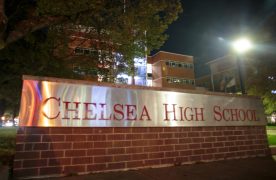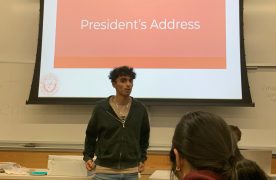Somewhere between the massive Thanksgiving dinner at my grandmother’s house, the hours spent lying on the family room couch catching up on the Osbournes and Lifetime Television for Women, and the various trips back and forth to the fridge for my third, fourth and fifth serving of Mom’s homemade apple pie, I devoted a very small amount of time to completing dozens of law school and graduate school applications.
The applications, which do not differ much from the dozens of college applications I completed four years ago, include generic background information, transcripts, recommendations and some sort of personal statement or essay. However, what was striking and what I don’t remember when applying to colleges were the ‘optional minority or special circumstances questionnaires’ attached to the university applications questionnaires that allow a student to explain any factors about family background, economic circumstances or special responsibilities that may have affected his or her academic performance.
Looking over the ‘optional minority or special circumstances questionnaire,’ there were no boxes I could ‘x’ or spaces I could fill in. I could not check the ethnicity box because I am neither American Indian nor Asian, Pacific Islander nor bilingual, African-American nor Hispanic. Nor could I indicate I was the victim of poverty, the inhabitant of a disadvantaged home or the child of divorcees nor explain how I support a family or single-handedly raise a child. And though I looked for it, there was no box for ‘white child of middle-class, privately schooled, suburban parents’ and there was no blank space for me to elaborate on my ‘Leave it to Beaver’ meets ‘Saved by the Bell’ cookie-cutter background.
To me, the ‘optional minority or special circumstances questionnaire’ was puzzling. Part of me couldn’t help but wonder if the discrimination, which affirmative action tries so hard to prevent, had somehow been reversed and released itself on our generation of unsuspecting high school and college students, who naively think that hard work and good grades are the only prerequisites for getting accepted at a university. But then, I thought, while affirmative action is not a perfect system, it does seem to have the best of intentions: to provide equal opportunity regardless of background, race, etc.
Therefore, to me, the concept of affirmative action seems a completely no-win situation a factor that may explain why the United States Supreme Court has continuously dodged the issue and refused to hear relevant cases. And not since 1978, when it ambiguously deemed sustaining racial quotas unconstitutional for federally funded colleges and universities in their application selections, have the nine justices agreed to tackle the constitutionality of affirmative action in the selection of college applicants.
But on Monday, the justices stepped or in the more geriatric cases shuffled, alongside the issue of affirmative action, back into the limelight to referee what could be a colossal battle in the making. On Monday, the Supreme Court justices granted certiorari to two pending lawsuits against the University of Michigan lawsuits filed on the premise that certain white applicants were denied admittance in favor of less-qualified minority students. From where they stand, the justices are posed to make the first significant ruling on affirmative action in the last quarter-century and perhaps make ‘optional minority or special circumstances questionnaires’ a thing of the past.
With the justices calling the shots, one side of the legal battlefield is the University of Michigan and its equal-opportunity admission policy. It is claimed in the lawsuit that the University of Michigan ran two separate admissions systems in order to generate a pre-determined racial profile of an incoming class. One admission system evaluated non-minority students on a 150-point scale, while a second system automatically gave blacks, Hispanics and Native Americans an initial 20-point advantage over the non-minority students. And while this system is now outdated and archaic, according to CNN, University of Michigan admissions officers, like the majority of private and public universities, freely admit to taking ‘race into account as a factor among many in order to pursue the educational benefit of diversity.’
Facing the university are two students who claim themselves victims of racial discrimination. They allege their test scores and grades far surpass those of accepted minority students. And while they may indeed have suffered at the hands of ‘reverse discrimination,’ the students were hand-selected from thousands of other potential white students as ‘perfect’ students by money-hungry lawyers and anti-affirmative action interest groups as the impetus of a monumental lawsuit against the university.
And tucked somewhere off to the side are two additional, and much more important, opponents: the United States Constitution and the university’s generic equal-opportunity credo. The former which abolished slavery, guarantees the freedoms of life, liberty and the pursuit of happiness and most importantly, demands that no individual or group is given advantages based on race or religion stands ready to clash with the latter a policy held by many public and private schools and insisting education is better served by diversity.
Affirmative action began as an attempt to rectify gross racial injustices of the past and in order to offer equal opportunities to everyone on the racial spectrum of the future. It made it possible for the children and grandchildren of poor minorities, who spent their lives and livelihoods as second-class American citizens riding in the backs of buses and sitting in the balconies of movie theaters, to receive the same opportunities in employment and education despite the economic and educational advantages within non-minority communities.
If the Supreme Court deems affirmative action unconstitutional, where does it leave the minority students of today? The ones who do not receive the same opportunities as non-minority students in more affluent communities? And yet, at the same time, if the Supreme Court lets affirmative action stay in place, what is going to regulate this seeming ‘reverse discrimination’ on the part of universities?
This June, the Supreme Court will make one of the most controversial decisions on affirmative action since 1978. ‘Optional minority or special circumstances’ questionnaires may become a thing of the past or they may be protected by the Constitution as a fixed element of the future. And in choosing between the two, the Supreme Court will inevitably make dramatic changes in the process of applying to institutions of higher education.
For now, however, I’m just thankful my applications are already in the mail.
This is an account occasionally used by the Daily Free Press editors to post archived posts from previous iterations of the site or otherwise for special circumstance publications. See authorship info on the byline at the top of the page.












